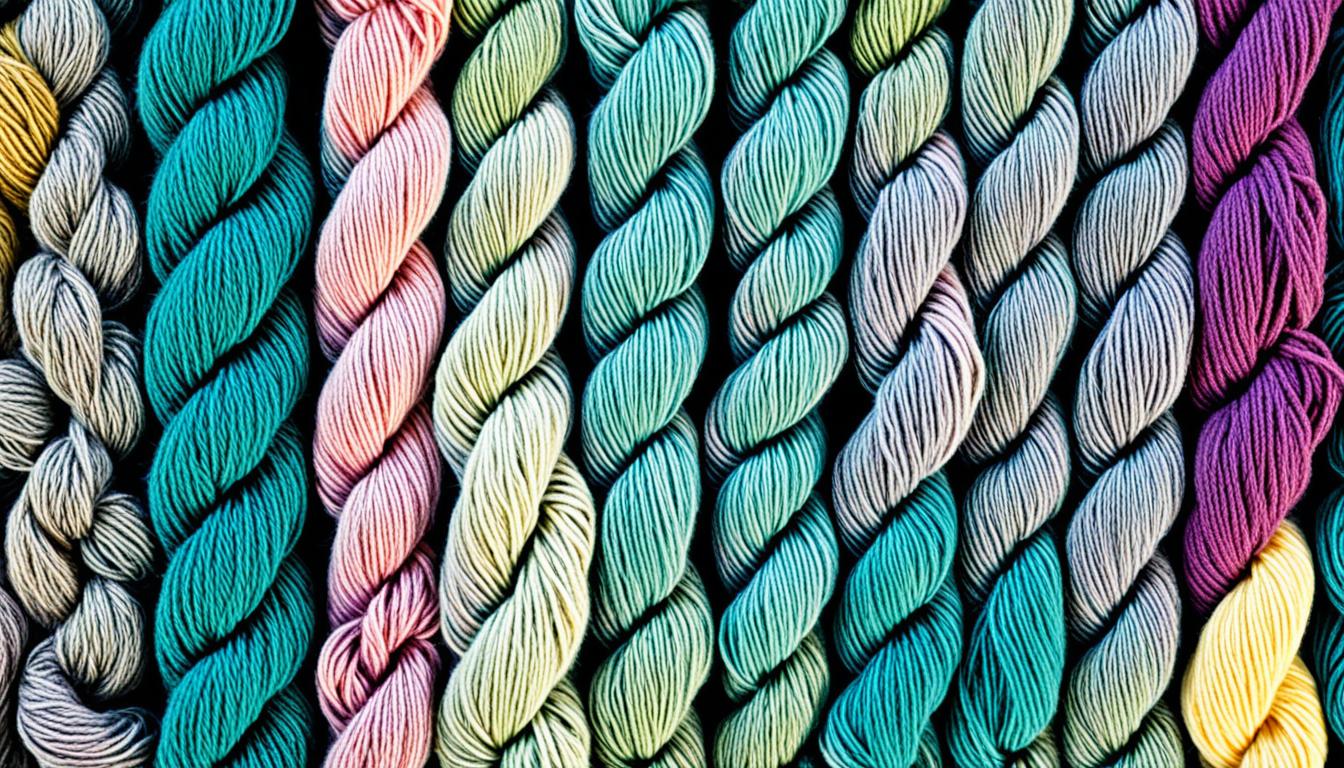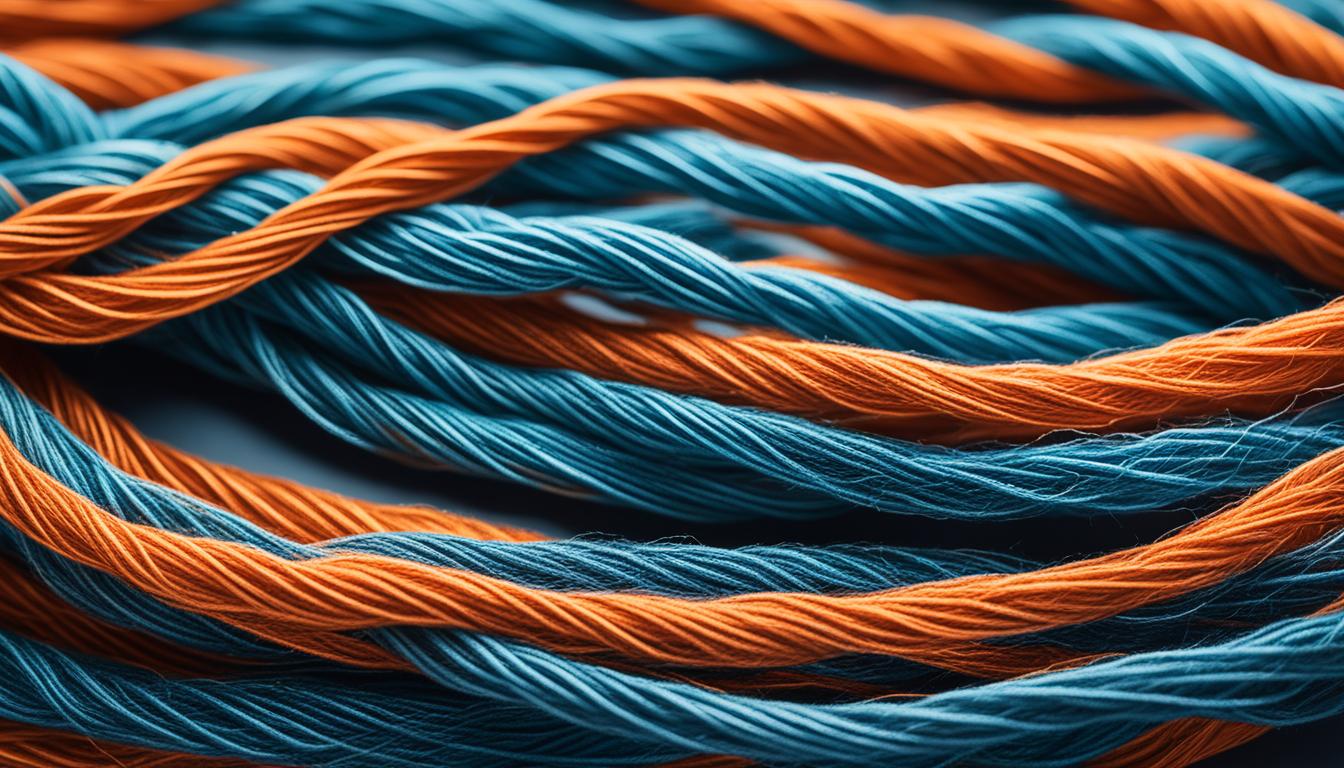When it comes to polyester, there is often confusion about its classification as a filament yarn. Many people associate polyester with fabrics that are woven or knitted from spun yarns. But is polyester really a filament yarn? Let’s dig deeper and explore the facts behind this question.
Polyester can indeed be classified as a filament yarn. Filament yarns are composed of continuous filaments of synthetic material that are twisted together to form a thread. Polyester filament yarns have distinct properties such as strength, durability, and resistance to stretching. They are often used in various applications including apparel, upholstery, and industrial fabrics.
The production process of polyester filament yarn involves extruding plastic pellets into filaments, which are then spun into yarns and woven or knitted into fabrics. This process offers flexibility in creating different specifications and characteristics for specific uses.
So, why is it important to understand whether polyester is a filament yarn? Knowing the classification helps us better appreciate the unique properties and benefits of polyester filament yarns. It also allows us to make informed choices in selecting the right yarn type for different applications.
In this article, we will delve into the various types of polyester yarns, the properties of polyester filament yarns, a comparison between filament yarn and spun yarn, the advantages of polyester filament yarns, their uses in different industries, the production process, and the specifications and characteristics to consider. By the end, you’ll have a comprehensive understanding of polyester filament yarn and its role in the textile industry.
Key Takeaways:
- Polyester can be classified as a filament yarn, composed of continuous filaments twisted together.
- Polyester filament yarns have properties like strength, durability, and resistance to stretching.
- They are used in apparel, upholstery, and industrial fabrics.
- Polyester filament yarns are produced through extrusion, spinning, and weaving or knitting.
- Understanding polyester as a filament yarn helps in making informed choices for specific applications.
Understanding Polyester Yarn Types
Polyester yarns come in various types, each with its own composition, structure, and characteristics. Understanding the different polyester yarn types can help you choose the right yarn for your project.
Textured Yarns
Textured polyester yarns have a crimped or textured appearance, adding visual interest to fabrics and providing enhanced softness and bulkiness. These yarns are commonly used in the production of garments, home textiles, and upholstery.
Spun Yarns
Spun polyester yarns are created by twisting short polyester fibers together. This results in a softer and more flexible yarn that is popular for its comfortable feel and natural look. Spun yarns are often used in knitwear, casual clothing, and accessories.
Core-Spun Yarns
Core-spun polyester yarns are unique as they feature a polyester core that is covered with cotton or polyester fibers. This combination allows the yarn to have the strength of continuous filaments while maintaining the sewing performance of spun yarns. Core-spun yarns are commonly used in sewing threads and heavy-duty fabrics.
Monofilament Yarns
Monofilament polyester yarns consist of a single synthetic filament. These yarns have a smooth surface and are often used for invisible or transparent stitching in applications such as hemming, quilting, and embroidery.
By understanding the different polyester yarn types, you can select the most suitable yarn for your project based on factors like appearance, softness, strength, and application requirements.
Properties of Polyester Filament Yarn
Polyester filament yarns possess a range of properties that make them highly versatile and suitable for various applications. These properties contribute to their durability, resilience, and overall performance.
Strength and Durability
Polyester filament yarns are renowned for their exceptional strength, making them resistant to wear and tear. They can withstand rigorous use and maintain their integrity over time. Whether it’s in textiles, upholstery, or ropes, polyester filament yarns provide a reliable and long-lasting solution.
Elasticity and Shape Retention
Polyester filament yarns offer excellent elasticity, allowing them to stretch and bounce back to their original shape. This property ensures that fabrics made from polyester filament yarns maintain their form even after repeated use and washing. It contributes to the longevity and appearance of garments and other textile products.
Chemical Resistance and UV Protection
Another noteworthy property of polyester filament yarns is their resistance to chemicals and ultraviolet (UV) radiation. This makes them well-suited for outdoor and industrial applications where exposure to harsh substances or sunlight is common. Additionally, polyester filament yarns are naturally resistant to mildew and other forms of fungal growth, enhancing their suitability for various environments.
Engineered Finishes
Polyester filament yarns can be engineered with different finishes to enhance their performance in specific environments. These finishes include moisture-wicking, anti-static, and flame retardant properties. Moisture-wicking finishes enable the yarns to efficiently draw moisture away from the skin, keeping the wearer dry and comfortable. Anti-static finishes reduce static charge buildup, making them ideal for applications where static electricity can be a concern. Flame retardant finishes provide added safety in environments where fire hazards are present.
Overall, the properties of polyester filament yarns make them an excellent choice for a wide range of applications in various industries. Their strength, durability, elasticity, resistance to chemicals and UV radiation, and the ability to incorporate engineered finishes make them a versatile and reliable option for manufacturers and consumers alike.
Comparison of Properties of Polyester Filament Yarn
| Property | Description |
|---|---|
| Strength | High resistance to wear and tear |
| Durability | Long-lasting and resilient |
| Elasticity | Ability to stretch and retain shape |
| Chemical Resistance | Resistance to chemicals and mildew |
| UV Protection | Shield against UV radiation |
| Engineered Finishes | Moisture-wicking, anti-static, flame retardant |
Polyester Filament Yarn vs Spun Yarn: A Comparison
When it comes to polyester yarns, two types stand out: polyester filament yarns and spun yarns. While they are both made from polyester fibers, they have distinct characteristics that set them apart.
Polyester filament yarns are crafted from continuous filaments that are twisted together. This manufacturing process results in a smooth and shiny appearance. Moreover, these filament yarns possess exceptional strength and are highly resistant to unraveling or pilling. They are ideal for applications where durability and longevity are important factors.
On the other hand, spun yarns are created by spinning short polyester fibers together. This process produces a softer and more textured yarn with a natural and organic look and feel. Spun yarns are known for their excellent draping qualities and are commonly favored for applications where a softer touch is desired.
“Polyester filament yarns are prized for their strength and resistance to unraveling, while spun yarns offer a softer, more natural texture.”
The choice between polyester filament yarn and spun yarn ultimately depends on the specific requirements of the application. If you’re looking for a fabric with a smooth surface and high strength, polyester filament yarn is the way to go. On the other hand, if you prioritize a softer feel and a more textured appearance, spun yarn might be the better option.
By carefully considering the desired texture, strength, and visual appearance, you can select the perfect polyester yarn for your project.
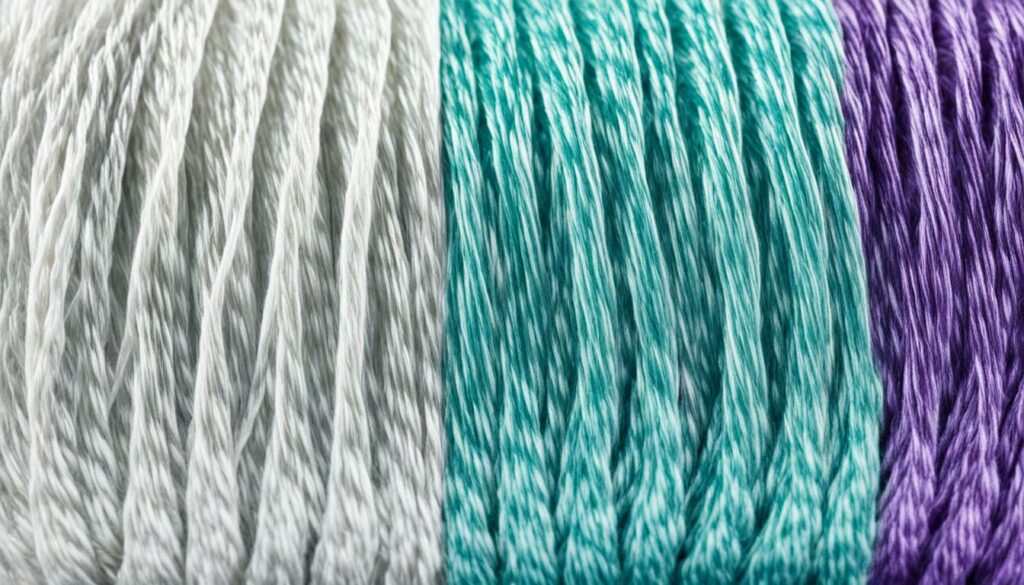
Advantages of Polyester Filament Yarn
Polyester filament yarns have gained widespread popularity in the textile industry due to their numerous advantages. Let’s explore some of the key benefits that make polyester filament yarns a preferred choice for various applications.
1. Durability
Polyester filament yarns are highly durable and can withstand the rigors of regular use and washing without losing their shape or color. This long-lasting characteristic ensures that garments and fabrics made from polyester filament yarns maintain their quality and appearance over time.
2. Dimensional Stability
One of the notable advantages of polyester filament yarns is their excellent dimensional stability. Unlike other fibers, polyester filament yarns do not shrink or stretch easily, maintaining their original shape and size even after multiple washes or extended use.
3. Tensile Strength
Polyester filament yarns possess good tensile strength, making them suitable for applications that require high strength and durability. This strength enables polyester filament yarns to withstand the stresses and strains of everyday use, ensuring the longevity of the end products.
4. Resistance to Wrinkles, Abrasion, and Chemicals
Polyester filament yarns are naturally resistant to wrinkles, making them ideal for garments and fabrics where a smooth and wrinkle-free appearance is desired. They also exhibit excellent resistance to abrasion, ensuring that the fabrics maintain their integrity even under harsh conditions. Moreover, polyester filament yarns are resistant to various chemicals, making them suitable for outdoor and industrial applications that may involve exposure to harsh substances.
5. Moisture-wicking and Quick-drying
Another advantage of polyester filament yarns is their good moisture-wicking properties. This feature allows the yarns to draw moisture away from the skin, keeping the wearer dry and comfortable. Additionally, polyester filament yarns are quick-drying, making them especially suitable for sportswear and activewear that require fast evaporation of sweat.
To summarize, the advantages of polyester filament yarns encompass durability, dimensional stability, tensile strength, resistance to wrinkles, abrasion, and chemicals, as well as moisture-wicking and quick-drying properties. These advantages make polyester filament yarns an ideal choice for a wide range of applications where strength, durability, and performance are paramount.
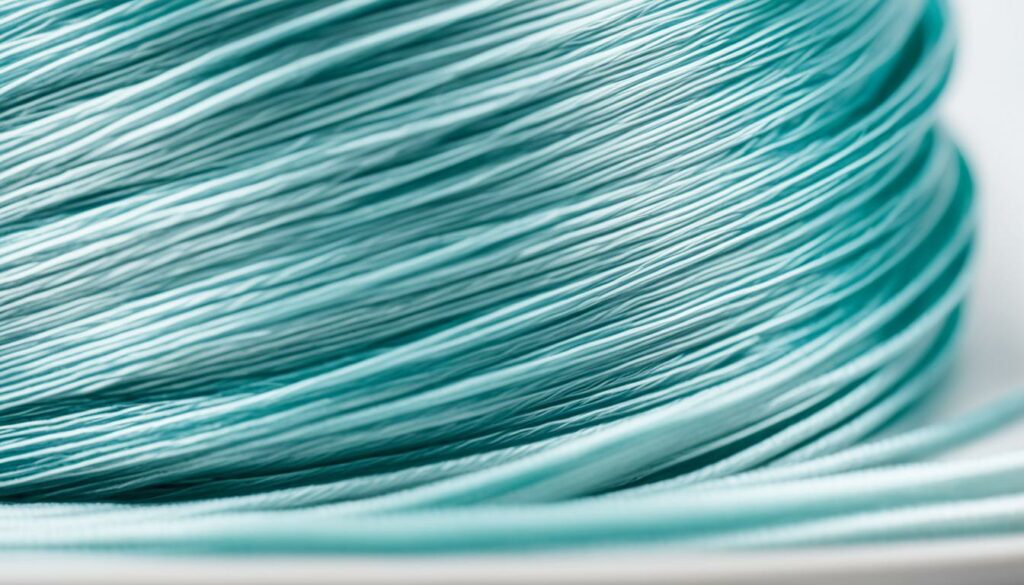
Uses of Polyester Filament Yarn
Polyester filament yarns have a wide range of applications across various industries. Their strength, stretchability, and moisture-wicking properties make them ideal for producing diverse apparel such as activewear, swimwear, and outerwear(polyester filament yarn uses).

These yarns also find extensive use in the manufacturing of technical textiles(polyester filament yarn uses). Geotextiles, which provide soil stabilization and erosion control, benefit from the durability and chemical resistance of polyester filament yarns. Automotive fabrics, such as seat covers and interiors, rely on their robustness and longevity. Industrial filters, designed to purify air and fluids, make use of their resilience and resistance to chemicals.
“Polyester filament yarns offer durability, chemical resistance, and superior performance in applications such as geotextiles, automotive fabrics, and industrial filters.”
For home furnishings, upholstery, and fabrics used in outdoor furniture and awnings, polyester filament yarns provide excellent strength and resistance to wear and tear(polyester filament yarn uses). Their ability to withstand exposure to the elements, including UV radiation, makes them a popular choice for outdoor applications. Additionally, the high strength and abrasion resistance of polyester filament yarns make them ideal for producing ropes, cords, and sewing threads(polyester filament yarn uses).
| Application | Uses |
|---|---|
| Apparel | Activewear, swimwear, and outerwear |
| Technical Textiles | Geotextiles, automotive fabrics, industrial filters |
| Home Furnishings | Upholstery, fabrics for outdoor furniture and awnings |
| Ropes and Cords | Ropes, cords, and sewing threads |
Overall, polyester filament yarns offer versatility and performance across various industries, making them a preferred choice for a wide range of applications. Their unique properties and characteristics enable the production of durable, high-quality textiles suitable for diverse end-uses(polyester filament yarn uses).
Production of Polyester Filament Yarn
The production process of polyester filament yarn is a complex and highly controlled operation that ensures the quality and consistency of the final product. It involves several key steps, which we will explore in detail below.
Extrusion of Plastic Pellets
The production of polyester filament yarn begins with the extrusion of plastic pellets. These pellets are typically made from polyester polymers, which are melted and forced through a spinneret, a metal plate with tiny holes. As the molten polymer is forced through the spinneret, it forms continuous filaments.
Melt Spinning
The continuous filaments produced during the extrusion process are then subjected to a technique known as melt spinning. The filaments are rapidly cooled using a cooling chamber to solidify them into a stable form. This solidification process is essential for maintaining the integrity of the yarn.
Stretching and Cooling
After the filaments have been solidified, they undergo a stretching process to align the molecules and improve the strength and elasticity of the yarn. This stretching is typically done using a series of rollers or godets, which pull the filaments at a controlled speed. The stretched filaments are then further cooled to set the molecular structure.
Twisting
Once the filaments have been stretched and cooled, they are wound onto bobbins and then twisted together to form a continuous yarn. This twisting process helps to increase the overall strength and stability of the yarn. The amount of twist applied can vary depending on the desired characteristics of the final yarn.
Additional Processing
Depending on the specific requirements of the end-use application, the polyester filament yarn may undergo additional processing steps. This can include texturing to create a textured or bulked yarn, or the application of finishes such as anti-static or moisture-wicking properties. These additional processes help to enhance the performance and versatility of the yarn.
Packaging and Distribution
Once the production process is complete, the polyester filament yarn is wound onto cones or spools for packaging and distribution. This ensures that the yarn can be easily transported and used by textile manufacturers in various applications.
Specifications and Characteristics of Polyester Filament Yarn
Polyester filament yarns offer a wide range of options in terms of specifications and characteristics, making them suitable for various end-uses. The following table presents some common specifications and characteristics of polyester filament yarn:
| Specification/Characteristic | Description |
|---|---|
| Yarn Count | The thickness or fineness of the yarn |
| Denier | The weight of the yarn fibers |
| Tex | The weight in grams of 1,000 meters of yarn |
| Twist per Inch (TPI) | Determines the strength and appearance of the yarn |
| Strength | The ability of the yarn to withstand tension and pulling forces |
| Elongation | The degree to which the yarn can stretch before breaking |
| Colorfastness | The resistance of the yarn to fading or running of dyes |
| Abrasion Resistance | The ability of the yarn to withstand friction and wear |
| Dyeability | The ability of the yarn to absorb dyes evenly and vividly |
These specifications and characteristics play a crucial role in determining the performance and suitability of polyester filament yarn for different applications. Manufacturers and end-users must consider them carefully to ensure the desired quality and functionality in the final product.
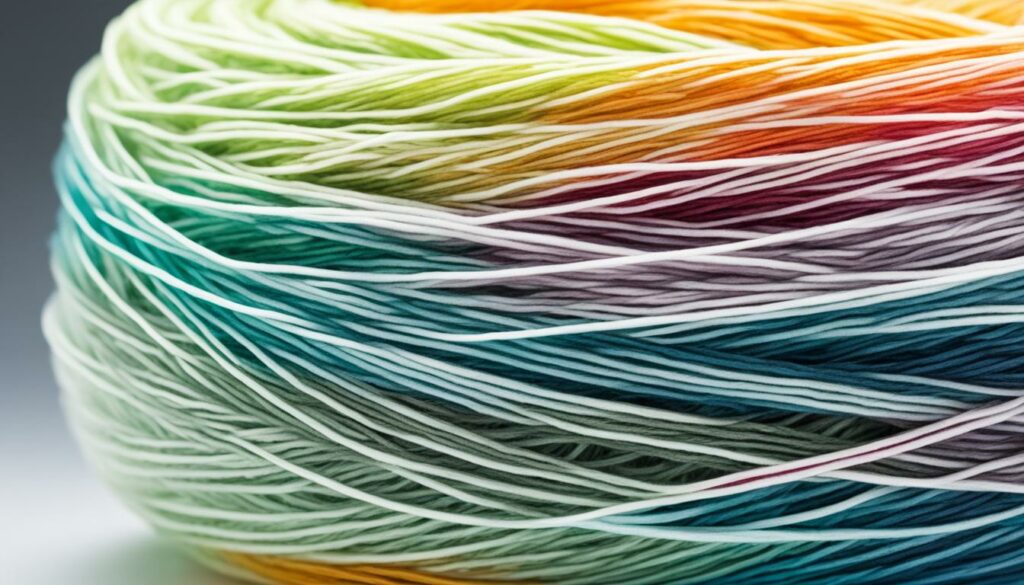
Polyester Filament Yarn: A Versatile Synthetic Fiber
Polyester filament yarn is a versatile synthetic fiber that offers a wide range of benefits in terms of strength, durability, and performance. It is widely used in the textile industry for various applications due to its distinct properties and characteristics.
Manufactured through a complex process, polyester filament yarn ensures consistency and quality. It can be produced with specific specifications and finishes to meet the requirements of different industries and end-users.
The use of polyester filament yarns provides opportunities for innovative and sustainable textile solutions. By offering a balance of performance, aesthetics, and functionality, polyester filament yarns contribute to the development of cutting-edge fabrics and materials.
With its exceptional strength, polyester filament yarn enables the creation of long-lasting and resilient textiles. Whether it’s for fashion, home furnishings, or technical applications, polyester filament yarn delivers reliable and durable performance.
Furthermore, polyester filament yarn’s versatility extends to its ability to be engineered with various finishes. These finishes can enhance specific properties, such as moisture-wicking capabilities, anti-static features, and flame retardancy.
Polyester filament yarns are at the forefront of textile innovation, driving advancements in diverse industries and enabling the creation of high-performance and sustainable products.
One of the key advantages of polyester filament yarn is its inherent resistance to stretching. This property ensures that fabrics made with polyester filament yarn maintain their shape and elasticity even after repeated use and washing.
The durability and resistance to wear and tear make polyester filament yarn ideal for a wide range of applications. From sportswear and activewear to upholstery and industrial fabrics, polyester filament yarn delivers lasting performance in demanding environments.
Sustainable Applications
Another significant advantage of polyester filament yarn is its compatibility with sustainable practices in the textile industry. The production process of polyester filament yarn can be optimized for resource efficiency and waste reduction, minimizing the environmental impact.
Additionally, polyester filament yarn has excellent dyeability, allowing for vibrant and long-lasting colors. This reduces the need for excessive dyeing and helps conserve water and energy during the manufacturing process.
By choosing polyester filament yarn, manufacturers can contribute to the development of more sustainable textile solutions without compromising on performance or aesthetics.
Overall, polyester filament yarn is a versatile synthetic fiber that continues to be a preferred choice in the textile industry. Its unique properties, durability, and adaptability make it suitable for a wide range of applications. Whether for fashion, technical textiles, or home furnishings, polyester filament yarn offers a compelling combination of performance, reliability, and sustainability.
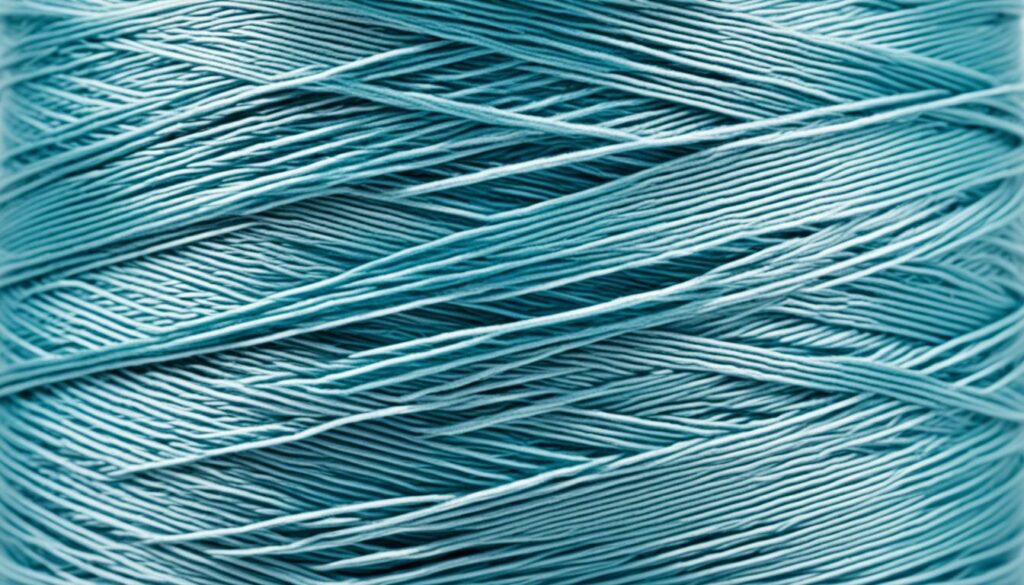
Conclusion
In conclusion, polyester filament yarn is indeed a type of filament yarn that offers numerous advantages. Its strength, durability, and resistance to stretching make it a preferred choice in various applications. Polyester filament yarns can be customized to meet specific requirements, allowing for flexibility in different industries. When deciding between polyester filament yarn and spun yarn, factors like texture, strength, and visual appearance should be considered.
Polyester filament yarn finds diverse uses across apparel, technical textiles, home furnishings, and ropes. Its production process involves extrusion, stretching, twisting, and winding, ensuring consistent quality. Specifications and characteristics, such as yarn count, denier, and twist per inch, play a crucial role in determining the suitability of polyester filament yarn for different applications. Overall, polyester filament yarn remains a versatile synthetic fiber that continues to serve as a reliable and sustainable solution in the textile industry.




